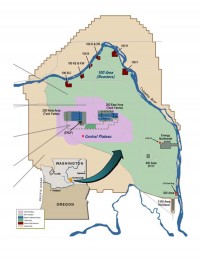Attend a Public Meeting to Learn More and Express Your Concerns
- PUBLIC MEETINGS: Come early to meet with Columbia Riverkeeper staff
Portland Meeting
When: Wednesday, November 18, 7:00pm
Where: Marriott Downtown Waterfront located at 1401 SW Naito Parkway, Portland, OR
Hood River Meeting
When: Thursday, November 19, 6:00pm
Where: Best Western located at 1108 E. Marina Way, Hood River, OR
The U.S. Department of Energy, WA State Department of Ecology, and the U.S. Environmental Protection Agency are proposing changes to the Tri-Party Agreement (TPA), the document that lays out the deadlines, called milestones, for the cleanup effort at Hanford. These TPA changes are substantial and include delaying cleanup plans for more than a decade in some cases.
WHAT ARE THE PROPOSED CHANGES?
Overall, the TPA agencies are proposing extensions for 9 milestones, modifications to 6 milestones, and an addition of 19 new milestones. Go here for the full version of the TPA changes and here for the TPA agency fact sheet.
Central Plateau
One of the more significant changes to the TPA involves the cleanup planning and completion of the Central Plateau. This area, also known as the 200 Area, is located in the center of the Hanford Site where nuclear materials were processed during plutonium production. During operations, radioactive and chemical wastes were disposed of in the ground. Today, hundreds of liquid and solid wastes sites are located in this area. For these sites (not including the waste tanks and processing facilities), cleanup planning was scheduled to be completed by 2016 with a final cleanup date of 2024. Under the proposed changes, cleanup planning has been pushed to 2026 and no final cleanup date is given, only TBD or To Be Determined. This is a major delay with a lot of uncertainty.
300 Area
Other delays of concern involve cleanup of some of the most contaminated sites located near the Columbia River in the 300 Area where laboratory research occurred and reactor fuel was developed and manufactured. These toxic sites include the 324 Building and the 618-11 Burial Ground, both having contaminated the soil with significant amounts of radioactive wastes. Changes to the TPA would delay cleanup of these sites by 3 years. While 3 years does not sound like a long time, any delay increases the risk of toxic waste entering the groundwater and the Columbia River.
WHAT CAN THE PUBLIC DO?
Ask questions! The public knows very little about how these delays will affect the rest of Hanford cleanup. Columbia Riverkeeper is seeking answers and so should you.
Here are some questions you should be asking during the meetings:
- Will these delays have a long term effect on human health and the environment?
- Will delays like this have an effect on Congress and their willingness to continue funding the cleanup?
- If the milestones of the TPA are routinely pushed back, what is the incentive for a fast and safe cleanup of Hanford?
- How will Energy be held accountable to a “To Be Determined” cleanup deadline?
- Will these delays cause other delays in Hanford cleanup?
- Are these delays setting a precedent for how cleanup will proceed?
- What can the public do to help cleanup proceed without further delays?
What we should be asking for:
- An end date for the cleanup of the Central Plateau – TBD is unacceptable!
- Prioritization of the 324 Building and 618-11 Burial Ground cleanup
- Details about how the delays will affect worker and public health, and the environment



